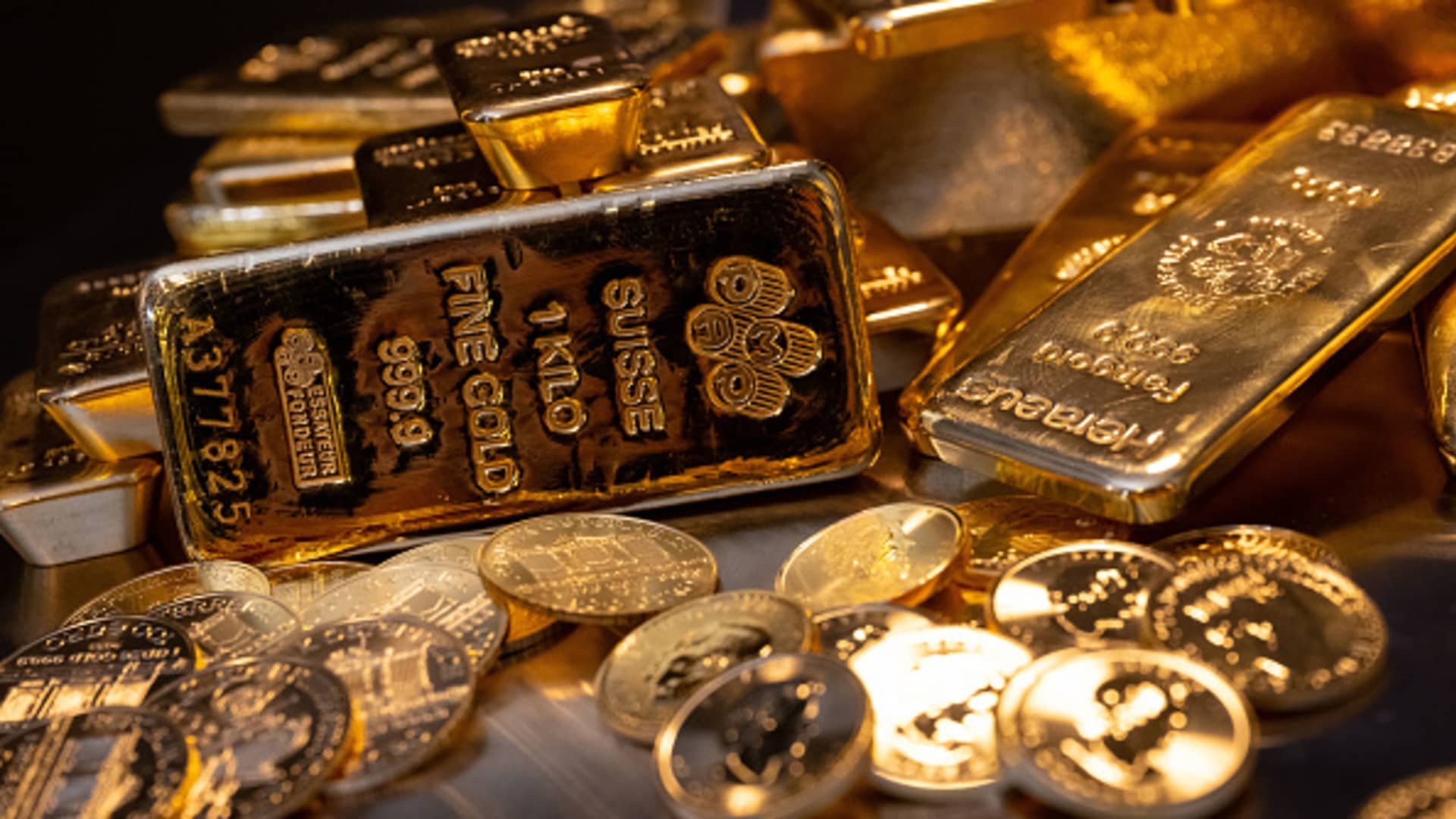
Sven Hoppe | Picture Alliance | Getty Images
Gold prices are on track to rally to all-time highs in 2024 on the back of tapering interest rates, and looming recessionary fears that elevate its role as a safe haven asset.
Spot gold prices hit a record intraday high of $2,072.5 on Aug. 7, 2020, according to data from Refinitiv. Analysts who spoke to CNBC say they could surpass that level and push beyond the record.
“I do see gold move above $2,100 in late 2023, early 2024 as a trading level,” said TD Securities’ managing director and global head of commodity strategy, Bart Melek, attributing his optimism to a potential pause in the U.S. Federal Reserve tightening cycle.
“I am positive on gold as I believe that the Fed will tilt policy away from its current restrictive mode. This I believe will happen before the 2% inflation target is reached,” Melek told CNBC in an email.
Spot gold was last trading at $1,912.26 per ounce.
2024 is when I see gold breaking out and reaching new highs and beyond.
David Neuhauser
founder of Livermore Partners
The Fed began its steady stream of rate hikes in March 2022, as inflation climbed to its highest in 40 years. In less than two years, it has raised borrowing costs to between 5.25% to 5.5%.
Gold has outperformed most other major asset classes in the past 12 months, Melek wrote in a recent report, attributing it to the yellow metal’s ability to resist rising interest rates and its value as a safe bet against inflation.
Recessionary fears
Some analysts are particularly bullish on gold, and have called for a target of $2,500 by the end of next year — that’s more than 26% higher than current levels.
“My target is $2,500 by the end of 2024 … Much of this has to do with the fact that recessionary forces may take hold beginning later this year and gain steam in 2024,” said David Neuhauser, founder of Livermore Partners. “2024 is when I see gold breaking out and reaching new highs and beyond.”
Neuhauser said he expects stagflation to persist in the global economy for the next few years as inflation falls to between 3% to 5%.

Can gold hit $2,500?
Gold tends to perform well in periods of economic uncertainty such as recessions and stagflation due to its status as a reliable store of value, and is often used as a hedge against inflation.
“I’m pretty confident that within a couple of years, we will see $2,500 gold,” said CEO of Wheaton Precious Metals, Randy Smallwood.
“Any type of recessionary move would be positive for gold,” he said, adding that he’s seeing weakness in the Chinese and U.S. economy.
UOB also forecasts that gold prices will set new records, but only by the second half of 2024.
“Key driver in our positive outlook for gold is anticipated peak in Fed rate hiking cycle as well as upcoming topping out of US Dollar strength,” Heng Koon How, the bank’s head of markets strategy, global economics and markets research, said in an email.
Gold should trade higher when interest rates stop rising and the greenback retreats, he explained.
We also see a return of physical gold jewelry demand from China and India as both economies stabilize and retail spending returns.
Heng Koon How
Head of Markets Strategy, UOB
Heng predicted that gold will trade at $2,100 per ounce by the second quarter of 2024.
Gold prices tend to have an inverse relationship with interest rates.
As interest rates rise, demand for gold drops as alternative investments like bonds become more appealing and yield better returns.
U.S. inflation fell to its lowest annual rate in more than two years in June, rising just 0.2% on a monthly basis. The Federal Reserve in July approved a much-anticipated interest rate hike that took benchmark borrowing costs to their highest in more than 22 years.
Higher consumer demand
Central bank purchases of gold have been “consistently strong,” alongside consumer demand for the precious metal, Heng pointed out.
“We also see a return of physical gold jewelry demand from China and India as both economies stabilize and retail spending returns,” Heng said.
Chinese retail gold demand has been resilient in 2023 even as consumption of other commodities remained weak, Citi said in a July report.
First quarter gold jewelry demand in China was “just shy of 200t, the strongest seasonal since 2015,” analysts led by Citi’s Head of Commodities Strategy Aakash Doshi said in the report.
Gold jewelry on display in Yichang, Hubei province, China, July 25, 2023.
Future Publishing | Future Publishing | Getty Images
Citi projects more than 700 ton of jewelry demand from China this year, marking a 22% year-on-year increase, it said.
Wheaton’s Smallwood said he’s seen an increase in consumer and retail demand. “Whether it’s jewelry, whether it’s bars, whether it’s coins. We have seen a pickup in that,” he said.
Physical demand for gold across some regions has returned, and central banks’ gold demand remains strong, said Nicky Shiels, Head of Metals Strategy at precious metals company MKS PAMP.
“Emerging market central banks continue to de-dollarize and utilize gold as an alternative in the event of any further Western sanctions,” she said.
BRICS countries, namely Brazil, Russia, India, China and South Africa, are also reportedly looking at moving away from the U.S. dollar to a new currency backed by gold.
